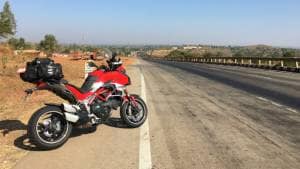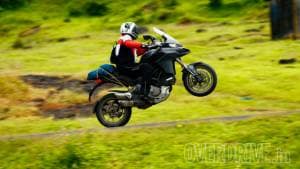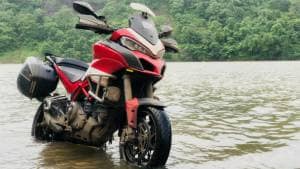Comparison: Ducati Multistrada 1200S vs Triumph Tiger Explorer XCA vs Triumph Tiger 800 XCA vs Honda Africa Twin
Snow-capped mountains and the sweet silence of the hills. Rays of sunlight kissing the mountain peaks early morning. The biting cold and that sense of a day ahead in which momentous things will happen. Ladakh is truly special. I first rode up there over 10 years ago on a motorcycle that's sort of attached at the hip to it, the Royal Enfield. But I haven't been up there in ages. To celebrate OVERDRIVE's 19th anniversary, Shumi planned out a ride up on very interesting motorcycles indeed. For years, I've yearned to ride an adventure tourer into the region. They're supposed to be built to take on the worst of terrains, engineered to take more of a battering than you can imagine and boast go-anywhere abilities unlike most motorcycles we know. Finally the dream is coming true.

The proverbial spanner landed on Shumi's leg and broke it at the Africa Twin ride, and he was removed, ahem, from the cast of characters. But the plan remained. We were going to ride the Triumph Tiger 800 XCA (Bert's bike), Shumi's Ducati Multistrada 1200 S, the all-new Honda Africa Twin and the just launched Triumph Tiger Explorer. Unfortunately, BMW Motorrad India doesn't have a BMW R 1200 GS we could use and Ducati's brand-new Multistrada 950 suffered a crash during the prep for joining our story. Joining Bert, Rohit and me were OVERDRIVE's usual hard-to-catch-tester-person Anand Dharmaraj from Indimotard. And the new face is Chennai-based Daniel 'Dodo' Anandaraj, a Chennai-based corporate type who also happens to be a hardcore rider, founder and owner Madras Bulls, president BOBMC and a legendary instructor at the Indimotard and OVERDRIVE TWO Track School.
Purely for logistics, we'd stick to the Delhi-Leh run. We've run it a gazillion times which makes it easier to understand what the bikes were up to. And anyone who's ridden up will tell you it's no walk in the park. It has become easier though. There's a lot more tarmac, for example. But the water crossings, the slush, loose sand and rocks, they're still there waiting to catch you out. This would be the ultimate endurance test. Oh, and there're the five high passes to cross, so we were not going to get to sit back and allow the motorcycles to do all the hard work. Let's not hang around and get right into it.
Ducati Multistrada 1200 S
The Ducati Multistrada has received glowing reviews every single time we have ridden or tested it. And that's because of its unbelievable performance and its ability to mix up the conflicting requirements of sportiness and comfort seamlessly. It also is the most powerful motorcycle on test. And it has the most technology too. Shumi's 7,500km Multi' received a set of fresh tyres and brake pads for this test, and it was the first motorcycle I climbed on to.
Which was a good call. The Multistrada makes the other motorcycles look large and heavy in the city. Its enormous power matches its incredible flickability and allows you to slice past traffic like a much smaller motorcycle.
Out on the highway, it continues to smash it out of the park. The run from Delhi to Chandigarh is 250km of wide open roads. The Multistrada essentially blasts the miles away endlessly. The 1,198cc brings a proper 152PS and 128Nm, and the only variable valve timing system here allows the Ducati to shame full-on sportsbikes in a straight line. The mind-boggling suite of electronics, thankfully, is extremely finely tuned towards enhancing your control over the power and capability of the Ducati and it all works. Is 8-level traction control, 3-level ABS, 8-level wheelie control required? I would say that it brings a gleam to the Ducati that I'd rather not do without.
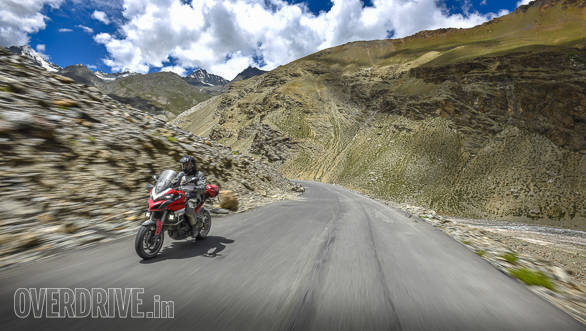
The star of the show is the semi-active suspension. Ducati's Skyhook Suspension uses the IMU and other sensors to figure out how to ensure the chassis stays level and stable by altering the suspension's damping. The changes happen instantly and the default selections change as you work through the four riding modes - Sport, Touring, Urban and Enduro. Preload adjustment is also a flick of a switch away with changeable presets available for rider, luggage and pillion on every conceivable combination. For this stretch, I stuck to the Touring mode, which allows me to use full power but a direct throttle response without the extra edginess that comes in the Sport mode.
What quickly became obvious is that Ducati is a brilliant highway machine but it's almost a tall sportsbike in flavour. Its reflexes are sharp and with this much power, you pretty much match or exceed all of the other bikes' speed with any gear changes being needed - as long as you're above 3,000rpm that is. It will sit at 150kmph if you like but I was going a bit slower, with cruise control engaged, in fact. The smooth roads were barely a workout for the suspension. The suspension soaked up whatever little undulations the roads had. And it all comes together. The plush ride, a good seat, an upright posture with slightly rearset pegs. You can ride the Multi' for hours without fatigue. I was, in fact, afraid that Dodo might get fatigued trying to keep on the Explorer. The fearsome highway poise and pace still doesn't prevent the Ducati from returning 250km on a tankful - over 15kmpl is easily possible at a 130kmph cruise.
Once we hit narrower mountain roads from Chandigarh to Manali, the Ducati continued to impress. The winding roads and its many corners felt great thanks to the grip and feedback of the 17-inch wheel, and the Michelins Pilot Road 4 tyres were excellent in mixed dry and slightly damp conditions.
The road started to dip and crest as we ascended further but the tarmac was still in good shape. The DSS makes short work of a situation like this. The agility and the confidence never wavered. Over tea on a break, Anand said, "The Ducati, you know, feels more like a street bike than a big adventure tourer. There is so much feedback from the front end around corners!" The bite from the brakes, support from the cornering ABS system and the natural grace of the Ducati made a hard 300km on all-day twisties extremely engaging. I cannot tell you how small and easy it feels to ride despite its size.
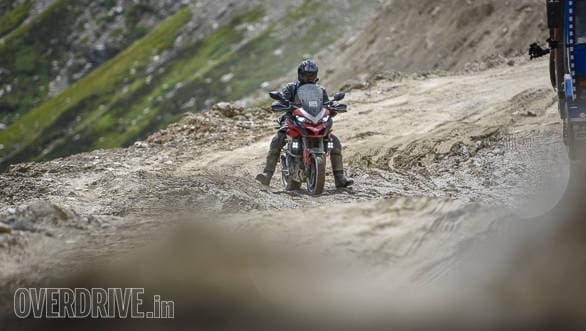
From Manali onwards through, the Ducati found the going harder, as the roads got worse. The very sporty bias that made it glow for the past 750km would make it one of the hardest bikes to ride here for the next 550km. For all the hard work the DSS put it and all that power and smoothness, the 17-inch front wheel cannot match the confidence of a 19- or 21-inch front wheel when traction is unpredictable. You realise that you're watching the road harder for the Ducati and that is tiring.
Descending from the Rohtang Pass to Khoksar and beyond, the roads improved and the Ducati gleamed once again. But from Jispa to Sarchu and Pang, the roads are pretty much non-existent. Unless you call rocks, boulders and dirt sections a road. Here the fastest bike on the test proved to be the slowest to make progress. The Ducati has the least suspension travel and while it never feels heavy (it's a relatively light 235kg with all fluids), the agility we enjoyed also made it nervous in the looser stuff. Switching to Enduro mode did help. It softens the power delivery and limits power to a manageable 100PS while allowing the rear wheel to spin a bit. But still, the Multi's hardcore sports focus costs it in this section.
When tarmac returned as we got on to the More Plain, we were all relieved. Protecting a `20 lakh motorcycle in hard going is extremely taxing. Plus the contrast between how well it handles tarmac versus how nervous it is in loose surfaces and hardcore dirt makes the Multistrada a polarising adv rather than a versatile one. Dodo said, "It was such a pleasure to find myself on the Multi' when the tarmac arrived. It meant I could stop worrying and start riding at a better pace." The smile lasted until Anand took the Multi, went off into the flat-packed dirt tracks and started sliding the Multi' about.
The final stint was easy for the Ducati. It's tarmac all the way and the Tanglang La descent has stunning scenery as well as awesome tarmac and more corners than you can count. The surface is as grippy as a racetrack and you could even try to get your knee down around some of the corners! What was more interesting was the fact that despite the high altitude, we're literally talking thin air with low oxygen and lots of accumulated dust, the Multistrada was running fine though it did feel slightly low on power.
The Ducati Multistrada 1200 S packs a fiery punch with its superbike-rivalling performance that's engine as well as chassis (on tarmac, heh heh). The dynamics are brilliant and the semi-active suspension is the dog's bollocks. The bike feels perfect for long hours on the highway with its excellent blend of rider ergonomics, ride as well as handling. All the technology also makes the Ducati a doddle to ride fast, no mean feat given its size. Indeed, Shumi reports stunning sharpness and manners from his recent track outing on the Ducati. Tarmac-demon? Check.
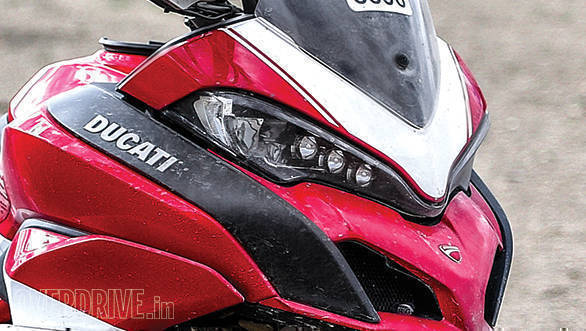
That very laser-focus and the 17-inch front wheel it requires is the issue for the Ducati as soon as the tarmac ends. Light off-roading you might manage but as soon as you get serious you see the Ducati as more tourer than adventurer. So if you do a lot of highway miles, commute, maybe even hit the racetrack a bit, with only a little bit of dirt riding in between, the Multistrada 1200 S is fantastic. You'll ride a 1000km a day without feeling it and be game for more. The electronics make for a great safety net and they functioned without a glitch over the course of this ride which speaks a lot about the reliability. We did break a brake switch in a water crossing which illuminated a warning. But since the Ducati only shows the warning for 10s before leaving a warning triangle on the dash, it causes some needless worrying too. Priced at Rs 19.72 lakh on-road in New Delhi, the Multistrada 1200 S is excellent, if mile munching is your thing.
Triumph Tiger Explorer XCx
When you switch to the Explorer though, you see that the Ducati isn't the only mile muncher here. The Explorer isn't as sharp or as sporty as the Ducati, but it also eats the miles for breakfast, lunch, dinner and midnight snack. The motorcycle here is the all-new, second-generation 2017 Tiger Explorer. It looks similar to its predecessor but the new Explorer is brand new under that familiar-looking chunky design. The 1,215cc inline-triple has received extensive changes and offers 139PS and 123Nm - the second most powerful machine in this test. Engine aside, it also gains a big jump in electronics. The Tiger now features cornering ABS and a 6-axis IMU along with semi-active suspension - the only Triumph currently to boast all of those things. It gets Road, Off-road and Rain modes, and they're adjustable just like they are on the Ducati. Full power is available only in Road mode by default.
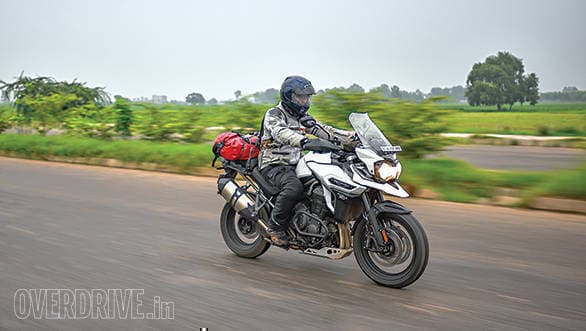
But the focus of the Explorer is directly the opposite of the Ducati. The British manufacturer says that it is a capable off-roader. On the highway, the Tiger had little trouble keeping up with the Ducati's blistering pace. With 139 horses on offer it felt quick and I particularly liked its smooth, linear manner. Throttle response was excellent and the Explorer seemed as hungry as the Multistrada in terms of munching miles at a feverish pace. The difference is in feel. While the Ducati feels compact and fast by nature, the Explorer feels substantial and in its element on the highway. The Explorer loves its size and it almost revels in it. At anything over 100kmph, the Explorer feels steady, relaxed and no matter how fast the Multi' went, the Explorer can match the pace without too much effort. You never forget its size and it feels more top-heavy on the move but none of that gets in the way, really. That being said, the Ducati has the better overall balance of the two. The chassis and suspension offer a nimble feel, masking the heft well. And it's got heft and a half. The Explorer is the heaviest here with a dry weight of 253kg - more than all of other bikes' wet weights. You're looking at over 300kg with fluids and luggage!
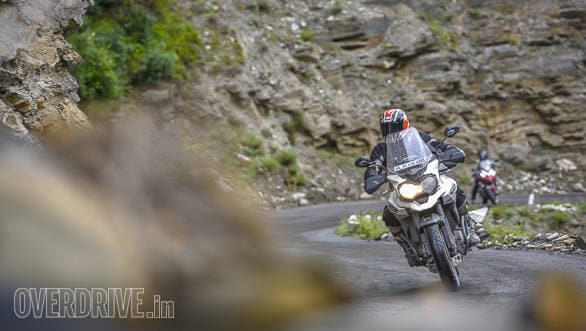
It is an excellent highway machine though. The bars are narrower than the Ducati and mounted just a smidge lower, but the footpegs are almost below your knees which makes standing up and riding if you need to, as well as sitting down through it all, as Dodo is wont to do, easier. Overall, this is a more relaxed riding position than the Ducati and the seat is just brilliant - no complaints at all. Its 20-litre fuel tank again offered a range similar to the Multistrada as we were able to get to Chandigarh without a fuel stop, which is very impressive for a 1215cc, 270kg motorcycle.
The chink in Explorer's composure is hard braking, especially from highway speeds. Stability on the move is excellent. But brake hard and even at its stiffest, the Explorer feels a little wallowy on the brakes as the front (190mm travel!) dives a lot and lightens the rear end. The extra weight, no doubt, contributes to this also.
The overall ride quality is just a bit softer than the Ducati so the stretch from Chandigarh to Manali was dispatched easily from the ride quality standpoint. But the bigger size and weight make the Explorer slower around corners. Strong engine mid-range performance helps, allowing good progress through corners and the short straights connecting them. Overtaking was a breeze too thanks to the smooth, linear power delivery.

While the roads were good, the Explorer rider has to work harder to keep up with the Multistrada. The size-weight plus the softer brakes make the Explorer a harder motorcycle to pilot. But as soon as the going gets rough, switching to 100PS Off-road mode made the Explorer easier to ride than the Ducati. The niggle is that while you can switch modes and preload on the Ducati without stopping, the Triumph requires you to stop and change modes and needs a few seconds to reset the suspension. But it's worth it. Broken sections were crossed a lot quicker and not just because of the pliant suspension but also the bigger 19-inch front wheel shod with dual sport rubber.
The climb down to Khoksar was quick despite the Explorer's size and heft. It was handling well but you had to put muscle into it. And that's almost the one problem that you run into again and again. The extremely capable Explorer is huge and heavy, and as soon as the going gets tough, you have to get past these two things. I discovered that the hard way when I tipped it over to the side at a water crossing strewn with round stones. The engine protection and handguards ensured nothing was damaged, but lifting up a 300kg motorcycle isn't humanly possible at altitude! I got the bike back up with help from a couple of guys but thereafter, whoever had to ride the Explorer across water crossings ensured they were on tenterhooks and tippy-toes. Of course, putting both feet down was not an issue given the adjustable seat height, which ranges from 837mm to 857mm.
When you hit the Sarchu and Pang stretch on the Explorer, it leaves the Ducati behind. It loves the dirt, this giant motorcycle. But when you ride the Tiger 800, you cotton on to just how much extra muscle and effort goes into riding the Explorer. The ABS on the rear wheel is switched off in Off-road mode you cannot change this setting which calls for caution on tricky surfaces.
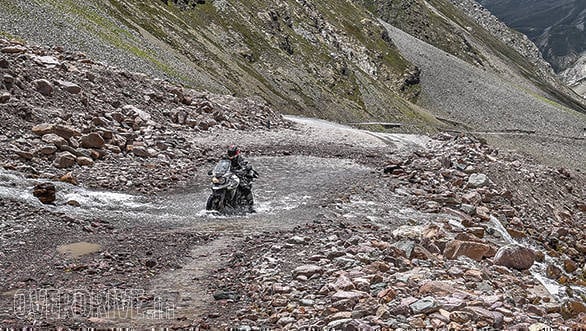 The Explorer's weakness is its weight, the 300kg laden can be exhausting in the hills. But ride quality is right up there, 190mm of travel on the front forks, 19" spoked wheels and tyres and a never-say-die motor almost make it a perfect recipe in the Himalayas
The Explorer's weakness is its weight, the 300kg laden can be exhausting in the hills. But ride quality is right up there, 190mm of travel on the front forks, 19" spoked wheels and tyres and a never-say-die motor almost make it a perfect recipe in the Himalayas
Off-road mode did make tackling the super-slow, rocky sections easy, and heft aside (one more time) the bike felt balanced and quick to make progress. We did collect a puncture and then thanked the lord, it gets spoked wheels and tubeless tyres. At More Plains the Explorer's 139 ponies were given a free rein again, and the bike didn't allow us to complain from there, all the way to Leh.
The Tiger Explorer is very capable as a full-sized adventure tourer. In pure highway work terms, it might even be a better motorcycle than the Ducati if sporty-reactive-sharp isn't your cup of tea. It's almost as good in the twisties and better on bad or broken roads. The equipment on offer is generous and in every instance, I felt that had the Explorer been 30kg lighter, this would be a very different story. If you can manage the heft though, the Explorer is a good choice to tour the world on two wheels. At Rs 20.76 lakh on-road New Delhi, it costs a lakh over the Multistrada though in that sense this isn't the better value for money between the two 1200s.
Triumph Tiger 800 XCA
Almost without intending to, I moved from the Explorer to the Tiger 800 and it immediately felt similar but smaller and much lighter. And there is, to be precise, almost 40kg in it! Which also means that the Multistrada 1200 and the Tiger 800 are approximately the same weight. Now, the 800 is easily the highest selling adventure tourer in India. The XCA is the fully loaded top model in that line-up. From auxiliary lights, a radiator guard, sump guard, hand guards, engine protection, centre stand and pannier frames, you name it, it's standard. Bert also added the Triumph panniers which complete the look. The Tiger 800 also has riding modes, traction control, ABS and cruise control.
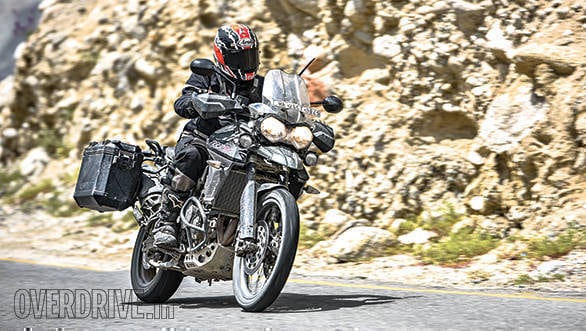
The 95PS/79Nm 800cc triple's power output does sound low after the big 1200s, but it's easy to forget that any two-wheeler approaching the 100PS mark is very, very fast. Visually, the two Tigers are similar and I prefer the slimmer lines of the 800. But that matte green colour is too mild for my taste.
Out on the highway, the 800 does have trouble staying with the booming 1200s when they're playing but it's a good tourer. It's slower but the power is smooth and overall feel is impressive. The cruise control system could have been easier to use - the Ducati's is a doddle - but the XCA, despite its off-road intent is a good highway motorcycle. While the tank is just a litre smaller than the 1200s, the harder work on the part of the smaller engine meant it went through fuel faster.

Not that you can tell that the Tiger 800 was working hard though. The 800's suspension is fully adjustable, but manually. The suspension soaks up undulations well, keeps the bike planted at speeds and maintains control when braking - impressive considering the 800 XCA's front suspension travel of 220mm. But as we've realised electronic suspension adjustment means you do actually fiddle with it to see if you can find a better setting. Only a handful of Tiger owners will ever actually change the stock set-up, and I'm going to include preload settings in that sweeping statement.
The Tiger is easy. The riding position is similar to the Explorer, the seat is good, and you can stand up and relax if you need to. Can an off-road ready motorcycle mile munch? Yes.
On the next stretch, the narrow mountain roads, the 800 was definitely working to stay with the 1200s but you don't really feel the strain. The bigger 21-inch front wheel hides the front contact patch and the dual sport tyres don't help in this regard. So it's a vague front end and progress is more cautious. Bert's bike also had worn tyres which meant still more issues. What shone though was the power delivery and the well-selected gear ratios, which made accelerating out of corners a breeze.
Manali to Pang showed the Tiger 800 in the best light. Bad roads is where it thrives, the 21-inch front wheel is precise over the bad roads and not deflected by rocks, dirt or water crossings. It also feels smaller than the Multi' the same weight though and that makes it easier to manage and move around on. Switching to Off-road mode helps but it was the suspension that was the most impressive part of the ride. Everyone who rode it between Manali and Pang had a big smile plastered on their face throughout.
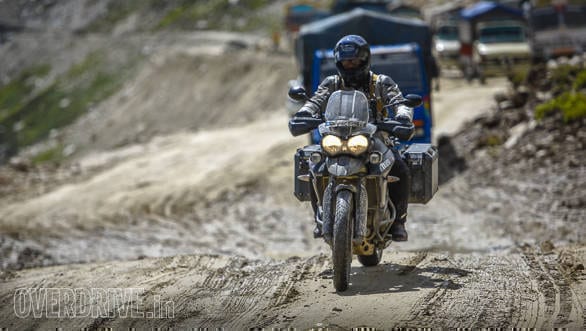
On the whole, surprise, it was actually quicker than the 1200s. The Multistrada was clearly begging for care and attention while the Explorer requires too much effort to be ridden at pace. In the same places, the Tiger 800 was just flying along cheerfully. Standing on the pegs and gripping the fuel tank with the insides of the knees was a lot easier on the 800 as well, which also gives you more confidence.
Up from Pang the 800 was good fun riding across the pristine tarmac at More Plains, especially with the sportsbike-like exhaust note, as we slammed up and down through the gears to go fast. There are still the massive dips in the smooth tarmac - you can get catapulted off the bike if get caught out. But the 800's suspension managed the undulations well, allowing the rider to sail along smoothly while bathing in the unearthly aura of the place.
 If possible, you could set your watch by the Tiger, that's how predictable it is! The XCA just happens to be the get everything you need, no fuss motorcycle in these parts and everywhere else. Best for beginners and mid-level riders, its linear power delivery, predictable manners thanks to that big 21" front and comfort features make it a brilliant ride out here. Extracting a litle more power, however, would certainly help it match pace with the others though it was never too far behind
If possible, you could set your watch by the Tiger, that's how predictable it is! The XCA just happens to be the get everything you need, no fuss motorcycle in these parts and everywhere else. Best for beginners and mid-level riders, its linear power delivery, predictable manners thanks to that big 21" front and comfort features make it a brilliant ride out here. Extracting a litle more power, however, would certainly help it match pace with the others though it was never too far behind
The 800 seemed to have lost some power at the high altitudes - as did they all - which made it feel slower. But the Tiger 800 is a well-rounded package. It's behind, but close enough on the highways and smooth roads and it smoothly and easily passed the 1200s once the roads get bad or disappear. The XCA costs `15.79 lakh on-road in New Delhi and it is loaded with everything you'd need if you wish to ride into unchartered territory. The Tiger 800 range though starts from about `12 lakh on-road in Delhi for the base XR, though it is more biased towards highway touring and gets alloy wheels - so less highway ability as well as far less gizmos than the XCA.
Honda Africa Twin
This is the motorcycle we were all angling for. The Africa Twin resurrects a legendary name and how. To me, this is the best-looking motorcycle here by far. The bike's bright red colour, white LED headlights and slim stance all made for a very distinctive look. The tall and skinny stance is further complemented by the compact 999cc parallel-twin , 90-section 21-inch front and 150-section 18-inch rear Dunlop dual sport tyres. This is hardcore.
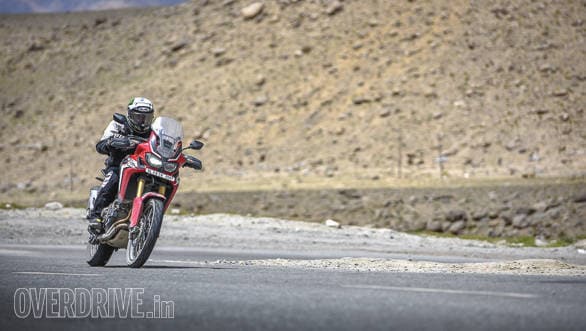
It is also unique. It is currently one of the only production motorcycles to feature a dual-clutch automatic transmission. I, for one, had my doubts about the system I wasn't too impressed with the dual-clutch transmission on the Honda VFR1200R. That one felt slow to respond but everyone reported a rosier picture from the Africa Twin media launch. So fingers crossed. The 245kg Africa Twin, also, is the least powerful motorcycle making 88PS and 91.9Nm.
It's also hard to start riding because you've to learn all the switches. There are a lot of them and many of them don't do what they usually do, or are not where they usually are. And two switches are on the fairing! A little too much to get used to? An owner will learn but short test rides will be, er, interesting.
In the place of the clutch lever, for instance, is a parking brake. So you use the rocker on the right switch to select Drive, release the parking brake and you're ready to roll. The same rocker also selects Sport 1, 2 or 3 if you want more aggression. I settled into Sport 3 for the highway, assuming I'd be working hard to stay with the more powerful machines. I needn't have worried. Strong bottom-end grunt beats the feelings 'just' 88PS should produce. The purist in me wanted to use the paddle shifts to change gears, but after a while I realised that the system usually knows what the right gear for the situation is. The Africa Twin's DCT is far more advanced than I expected and as intuitive as highway work might call for.
It wasn't long before the four of us were joking about the Africa Twin being a 'big Activa', given the convenience of the DCT. A mere twist of the wrist drops a gear to accelerate for overtakes and without the need to use a clutch or gear lever, the bike was easily the most convenient.
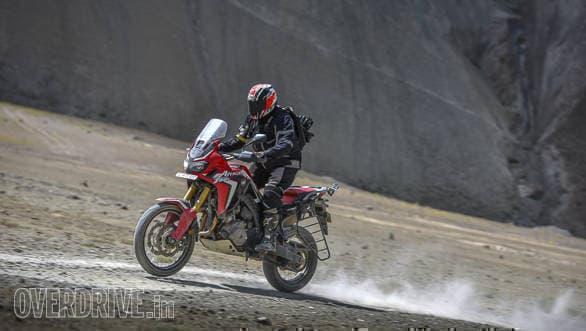
While there aren't really any complaints, you slowly begin to realise that the Africa Twin is the most un-touring of motorcycles on the highway in feel and behaviour. Not hard to explain if you consider its rallying and off-road heritage. The Africa Twin doesn't get an adjustable windscreen, and Bert, one of the shorter riders, complained of the buffeting from the tall screen.
The off-road genes could also explain the rock hard seat that required you to either squirm a lot (Dodo), or stand up and ride for a while (all the others). The suspension is fully adjustable but at 230mm, the ATwin has the most suspension travel of them all. It feels springy and absorbent like a dirtbike and bumps disappear completely. Honda claims the Africa Twin will offer a tank range of up to 400km if ridden carefully in Drive mode. Our enthusiastic riding in Sport mode had the fuel light come on a while before Chandigarh itself - perhaps we did wring it a bit too much.
It felt more at home the next day on the smooth mountain roads, particularly thanks to the strong thrust from the engine. However, we found that that DCT system, especially in the twisties, gets in your way a little bit. Sometimes, it doesn't downshift early enough. For instance, I would finish braking, lean in and it would downshift as I came back on the throttle, unsettling me mid-corner. Switching to full manual mode solves this issue. But there were a few times when Bert and I both downshifted when a cow or something crossed the road instead of honking.
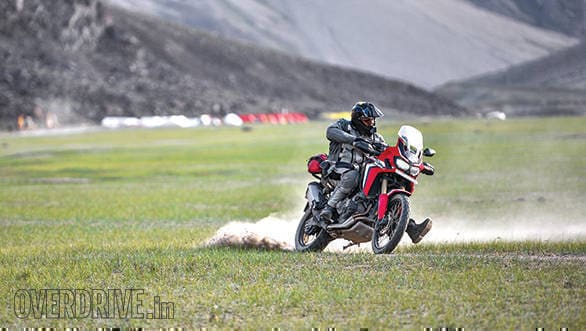 The Africa Twin's DCT should make it the best mile-muncher there is, but it's sadly neither here nor there. A manual tranny would give it the focus most are seeking from it, still it's the sweetest to ride over all the rough stuff, be it for work or play! Automatic is too fidgety, and switching to manual mode defeats the purpose. Honda could also sort out some of its ergonomics, complicated switchgear. Given its reputation, the Africa Twin also claimed the most attention wherever it went. Its purpose is, however, lost in translation
The Africa Twin's DCT should make it the best mile-muncher there is, but it's sadly neither here nor there. A manual tranny would give it the focus most are seeking from it, still it's the sweetest to ride over all the rough stuff, be it for work or play! Automatic is too fidgety, and switching to manual mode defeats the purpose. Honda could also sort out some of its ergonomics, complicated switchgear. Given its reputation, the Africa Twin also claimed the most attention wherever it went. Its purpose is, however, lost in translation
The Africa Twin was impressive in the hills. It changes direction quickly and the only issue is the same as the Tiger 800. The 21-inch front wheel turns the volume down on feedback and despite the suspension's stability, it makes fast tarmac corners more vague. The Africa Twin wasn't as much fun as the Ducati, or as confident as either Tiger around tarmac corners, but a switch to different tyres should help.
After Manali, just as the Ducati started to struggle, the ATwin started to shine. It's pretty much the polar opposite of the Italian machine. The Ducati loves its tarmac and takes a stab at dirt. The Honda loves it dirt and gets through the tarmac stretches. I was laughing inside my Lorenzo helmet at the ease with which the Honda was flying through the changing terrain. And as Shumi will tell you, a smile in a Lorenzo helmet is a thing to cherish. An exceedingly rare event.
Where we dreaded water crossing with the Ducati, we looked forward to them with the Honda. The 21-inch wheel, the massive ground clearance, the suspension, it all means that the Africa Twin just flies through the varying Ladakhi conditions. I passed many stationary Royal Enfields before I realised that they were, in fact, moving and I was flying along at a god-like pace.
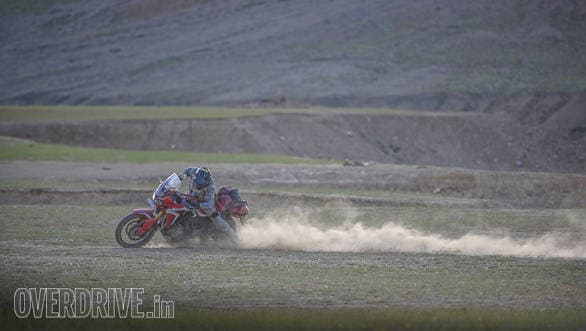
You can do that because the suspension takes it all in its stride. You never feel the 245kg weight and you can literally think of it as a dirt bike and go for it. By the time we hit Pang, we had no doubts about the Africa Twin was the most fun motorcycle for the worst of the roads. Switch rear ABS off and drop traction control to the minimum, select S1 and you can leave all the other three in the dust. Bert, in fact, I literally left in the dust. I wasn't there when he fell off the Multi'. That said, I couldn't for the life of me tell what the Gravel mode switch does.
On the undulations of the More Plain, the Honda continues to dazzle using its suspension travel and set-up to soak up the dips a lot better than all the other bikes. From there to Leh was a breeze for the Africa Twin again, as its lightness and agility were a big help chucking it into the fast bends on the smooth, grippy tarmac. It's only in these situations where you wish for more tarmac-oriented feedback-rich tyres, honestly.
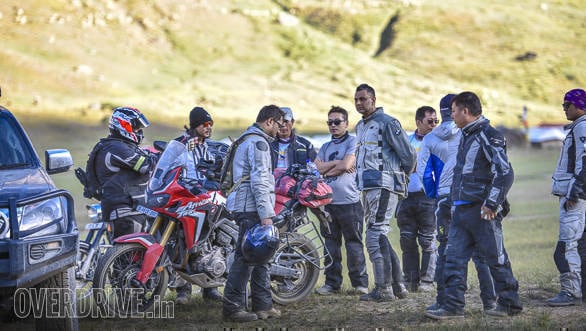
The Honda confused me a little. It was undoubtedly the most fun, most indestructible, most capable ride bike of all when the roads got bad. It takes the battering without a flutter and in the gravel, over rocks and in the water, it's the best handler of all too. It's not the happiest of the lot on tarmac but it isn't cumbersome or boring. It's just not as happy to go fast on tarmac as the others. Oh and it is the most affordable motorcycle of the quartet at Rs 14.47 lakh on-road New Delhi. Welcome to the game, Honda!
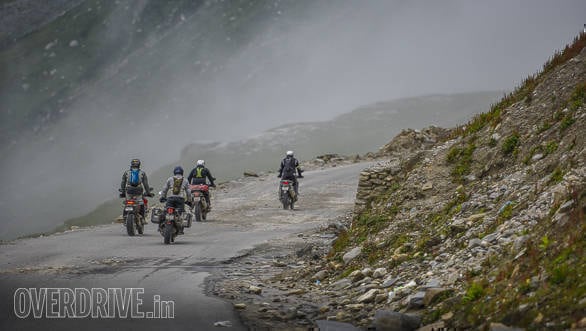 Standing up or sitting down, the pace, comfort, confidence and sheer joy this quartet is able to generate at these altitudes is unparalleled
Standing up or sitting down, the pace, comfort, confidence and sheer joy this quartet is able to generate at these altitudes is unparalleled
Electronics
The four motorcycles here mark the pinnacle of adventure motorcycle engineering in many ways. Their electronics not only help rein in the power, but also make the bikes a lot safer than you could imagine. Common to all four are traction control, ABS and ride-by-wire. The Ducati and both Triumphs also get cruise control, while the Africa Twin doesn't. There's a few rider aids unique to each motorcycle. Here's the lowdown of the electronics on each motorcycle.
Ducati Multistrada 1200 S

Riding modes on offer are Sport, Touring Urban and Enduro. Sport and Touring offer the full 152PS though delivery is softer in Touring. The output is dropped to 100PS in Urban and Enduro modes with an even gentler throttle response. Traction control (8 levels), ABS (3 levels) and wheelie control (8 levels) can be customised in each mode. The Multistrada is the only bike here to get wheelie control. It also gets electronically damped semi-active suspension with adjustable preload.
Then there's the IMU or Inertial Measurement Unit which checks pitch, roll and yaw movements to adjust traction control and ABS intervention. The Multistrada also gets cornering ABS. Features unique to it include cornering lights, Bluetooth connectivity and backlit switches. Bluetooth module lets you pair your phone to the bike there's a dedicated app that records ride data.
Triumph Tiger Explorer XCx

The Explorer also gets semi-active, electronic suspension and a six-axis IMU. Riding modes include Road, Rain and Off-road, with various parameters including engine maps, traction control levels and ABS levels customisable for each mode. But to change rider modes you have to come to a halt and wait a few seconds to let the suspension complete the transition. Importantly, Off-road mode switches ABS off for the rear wheel; this setting cannot be changed.
Triumph Tiger 800 XCA
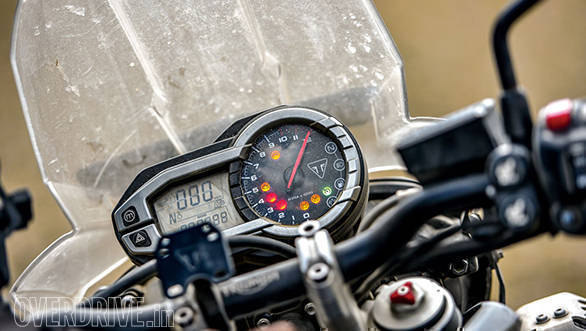
The Tiger 800 gets Road, Off-road and a customisable Rider mode. Modes do not change power output but alter power delivery. Parameters like throttle maps, ABS and traction control are adjusted accordingly. The Tiger 800 also gets cruise control.
Honda Africa Twin
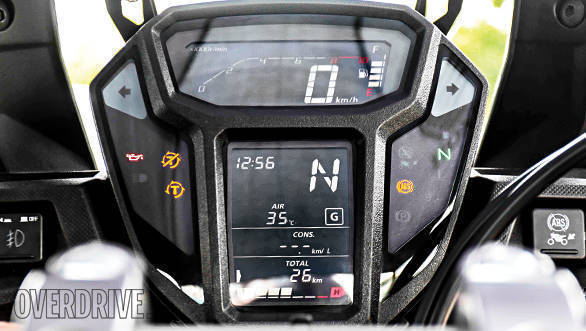
The Africa Twin misses out on cruise control, but gets three traction control levels. It features four riding modes in total, as this is the DCT-equipped version. It gets Drive, Sport 1, Sport 2 and Sport 3, with the gearbox allowing you to hold revs in each gear incrementally. The Africa Twin also gets a separate Gravel mode which is said to simulate the feeling of clutch slip. There's an independent switch to switch rear wheel ABS off as well, something the other bikes here don't get.
Headlights
The Multistrada 1200 S and Africa Twin both get full LED headlights, and the Ducati's lights also integrate a set of cornering lamps. Both Tigers use more conventional halogen lamps for the main headlights. The Tiger 800 XCA, being the range-topper, also gets a set of standard auxiliary lights. The Ducati's headlights offered the best spread and illumination. Its cornering lamps did an excellent job of illuminating corners too.
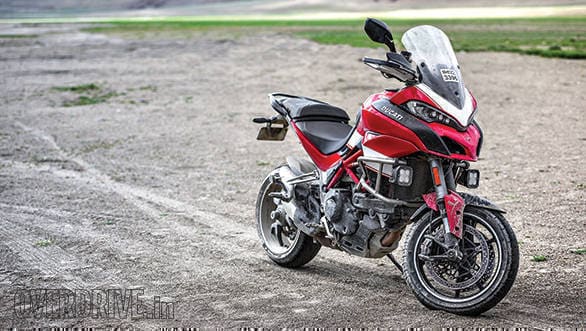 The Multistrada is simply stunning to look at in this landscape or anywhere else. But it's too top heavy, with too much power and too little tyre for the terrain!
The Multistrada is simply stunning to look at in this landscape or anywhere else. But it's too top heavy, with too much power and too little tyre for the terrain!
Shumi has equipped his Multistrada with aftermarket Denali D4 lights, and illumination from all lights together turns the night into day. The Multi was followed by the Tiger 800, thanks to the additional spread from its auxiliary lights.
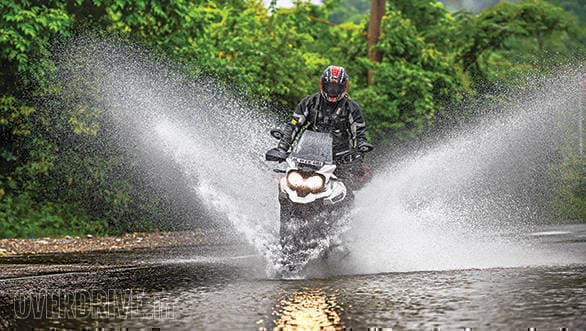
The Tiger Explorer's lights offered just about enough illumination but more power from the auxiliary lights would have been welcome.

The Africa Twin's half-round LED headlights look nice but could have offered better illumination, and getting aftermarket lights for your Africa Twin should be a good investment Honda does sell a pair.
Tank range and efficiencies
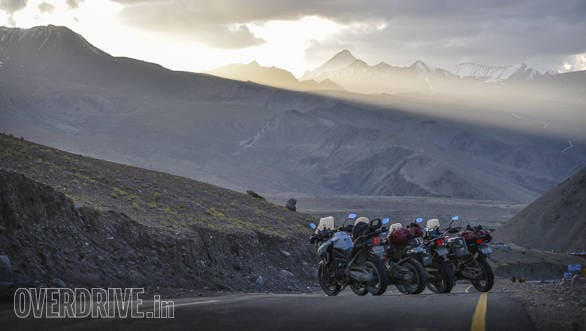
The Multistrada 1200 S and Tiger Explorer use 20-litre fuel tanks each, the Tiger 800 a 19-litre tank and the Africa Twin an 18.8-litre tank. Our high-speed highway run from Delhi to Chandigarh had the Multi and Explorer return about 13-14kmpl each, while the Tiger 800 and Africa Twin returned about 11-12kmpl each. Not ironic, since the Multi and Explorer easily cruise at lesser revs at high speed, whereas the 800 and the ATwin work hard to match pace. Once we were in the hills, speeds were saner, but here the Multi and Explorer struggled with efficiency, given they needed more throttle inputs on the rough terrain than the 800 or ATwin. The 800 and Africa Twin did not need a refuel after Jispa, but both the Multi and Explorer did. Given the uncertainties and varied terrain, all four motorcycles thus offered a tank range of about 270km realistically.
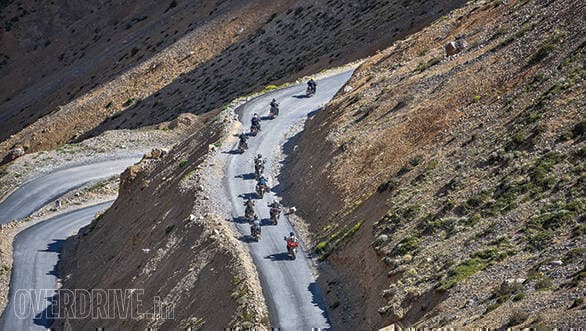 The big adventure motorcycles are a much quicker lot in the mountains! It's easy to zip past the smaller, less powered cruisers that are crowd favourites in Ladakh
The big adventure motorcycles are a much quicker lot in the mountains! It's easy to zip past the smaller, less powered cruisers that are crowd favourites in Ladakh
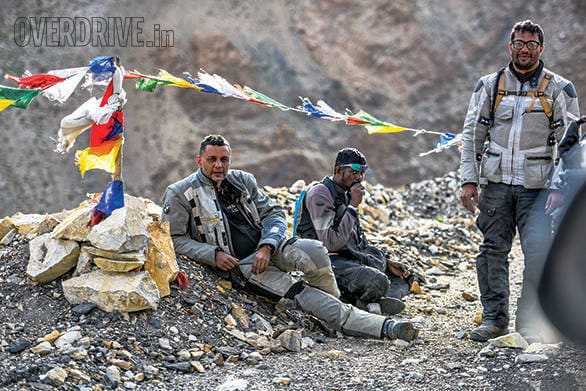 They are less exhausting also, we kept taking breaks for the cameras!
They are less exhausting also, we kept taking breaks for the cameras!
Front wheel sizes
The four motorcycles in this test have different front wheel sizes,ranging from 17- to 21-inches, each serving a different purpose. The Multistrada 1200 S is the only bike to use a 17-inch front wheel. The Tiger Explorer XCx uses a 19-inch front wheel while the Tiger 800 XCx and Africa Twin use 21-inch front wheels. A 17-incher is used on motorcycles meant for road use primarily. Riding fast on tarmac is about the directness of the steering and communication from the front end, and a 17-inch wheel is also the best bet for stability around corners. This also explains the Multistrada's road bias and sportsbike-like handling, not to mention, the brilliant corner manners.
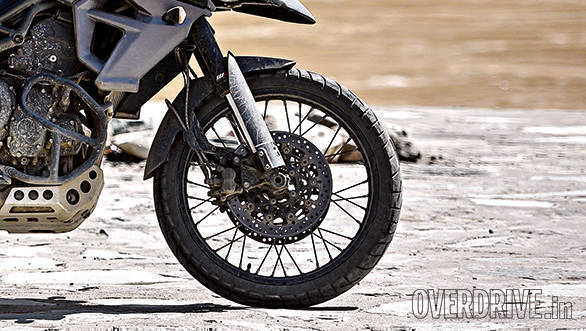
On the other hand, the larger the front wheel, the better suited it is for riding on dirt or broken roads. The bigger wheel generates more gyroscopic stability which helps manoeuvre through dirt or loose gravel better, apart from helping the bike go quicker over rocks or, boulders. In essence because it's harder to deflect the wheel off its path because its bigger and usually slightly heavier.
The Tiger Explorer's 19-inch front wheel is thus a good compromise as it offers the best of both worlds. The Explorer may not be as confident or communicative as the Ducati on tarmac but is definitely better off it. It was a whole lot better when it came to tackling the bad, broken and non-existent roads from Sarchu to Pang.
The Tiger 800 XCA and Honda Africa Twin's confidence over broken roads, water crossings and dirt sections was exemplary given their 21-inch front wheels. Both were able to leave the Explorer and Multi in their dust off tarmac, were barely able to catch up with them around corners on smooth hill roads. The 21-inch tyres were slimmer as well the Tiger 800 and Africa Twin both use 90-section front tyres to plough through the dirt quicker. That's 30mm less contact with the tarmac as compared to the 120-section fronts of the Multi and Explorer. This robbed us of feel and feedback in the hills, which in turn cost confidence to go faster or lean as much as the Multi and Explorer.
Verdict
All right. First, if you haven't been to Ladakh on a motorcycle. Please go. There's something in the mountain air, in the place that is magical. Yes, it does seem to be crawling with ever more bikers but better to have been there than not. And you couldn't do better than take an adventure tourer for the journey. They do a lot of hard work so that you can relax, look around and absorb the beauty. Or so that you can paste that throttle, have your engine's bellow echo off the mountains as you tear it up to the highest mountain passes on Earth.
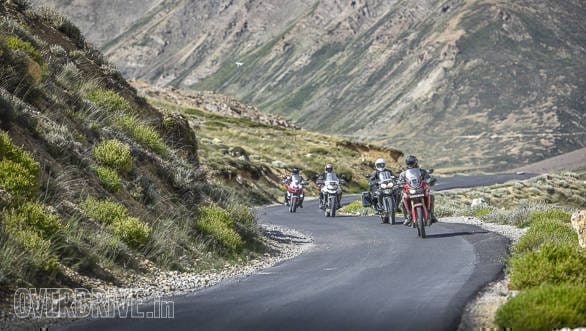
What this test reveals is that all adventure tourers are not born equal. Actually, that we knew. What we weren't expecting is how focussed the dwellers of this general purpose motorcycle category are.

The Triumph Tiger Explorer, for example, is an accomplished highway motorcycle. It isn't very sporty in design or nature and its heft stops it from doing all the things the Africa Twin or the Tiger 800 manage in iffy conditions or off-road. But it's hugely competent, well-equipped and perhaps the only niggle is having to stop to switch modes. The beauty of it is that it stays like that once the road ends too. On its own, you wouldn't question its effortless performance, although the weight is always an attendant concern. In this company, though, the Tiger Explorer does feel like the least value for money. The highest price tag here and the highest weight in the group are, literally, the two things that hold this Triumph back.
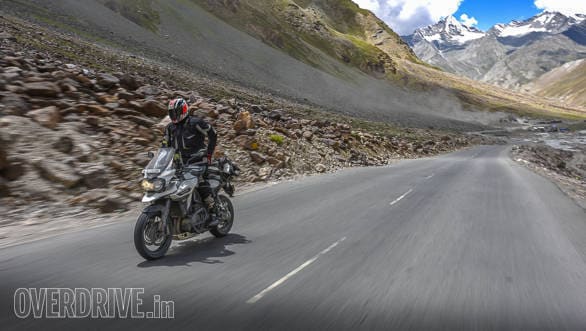
Holding the Africa Twin back is how much its off-road focus interferes with its tarmac ability. It is a 1,000cc dirt bike. Not much more, and certainly no less. It comes alive each time you get bad roads or dirt. The Africa Twin felt like a (large) mountain goat whenever it came to trail riding. Anand took every shortcut he saw and the Africa Twin handled it all easily. It handles the highway reasonably well too. The reason to enjoy the best price in the segment then is easy to see. If you're serious about riding off-road, this is the most competent motorcycle you can buy. The reason why it's in third is the simplest one of all. The Ducati is as great on-road as the Africa Twin is great off-road. But until more people ride off-road as regularly as we take to the roads, the Africa Twin is, by three microns, in third.
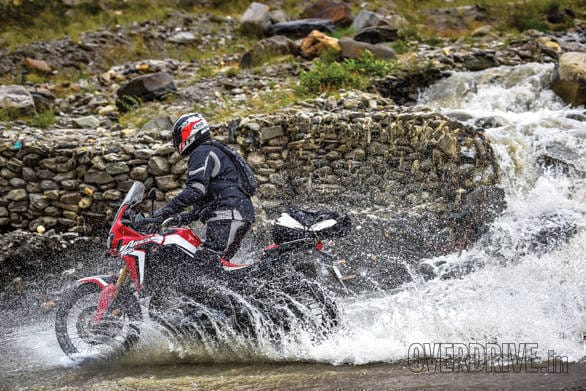
And just like the Africa Twin is a cross between Anand Dharmaraj and a Himalayan Ibex, the Ducati Multistrada 1200 S is impossibly good. It's hugely, frighteningly powerful, laden to the gills with technology and feels like a much smaller machine would be proud to. On tarmac, it's massive fun and in a blend of highway, twisties and a racetrack, it would be unbeatable by almost anything you can care to name, including these three. But the supersonic tarmac ability is precisely what stops it from excelling once the road ends. Light off-road riding, and I really do mean light, is about all the Ducati manages with enthusiasm. It will get to Leh, no problem. But the last 550km of hard roads are better attacked with other tools.
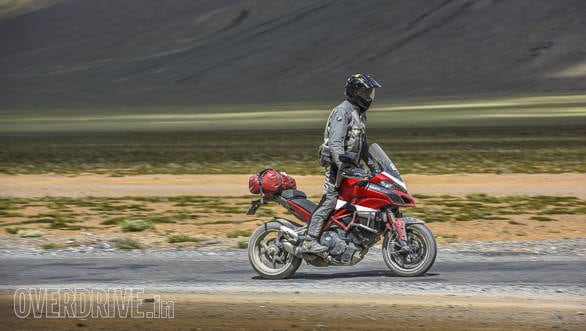
That brings us to the surprise winner of the test, the Triumph Tiger 800 XCA. The smallest machine here. Maybe we shouldn't be surprised. You won't spot a specific kind of terrain, place or pace at which the Tiger 800 outperforms either the Africa Twin or the Ducati if you consider them to be the bookends of the spectrum. But then you look back and realise that the Tiger 800's always the bike in second place.
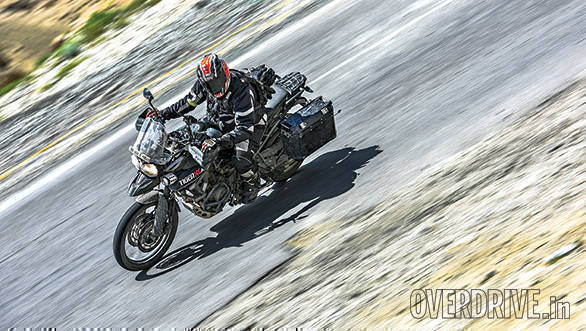
Whether it's city commuting, highway droning, mountain twisties, bad roads or no roads. The headlights in the mirrors of the leader are always the Tiger's twin octagons. Triumph has an extremely well-executed adventure tourer in the 800. From 1,000km days to bad terrain, the Tiger knows what to do. It's a winner. Besides, this Tiger belongs the editor-in-chief. Follow the leader.

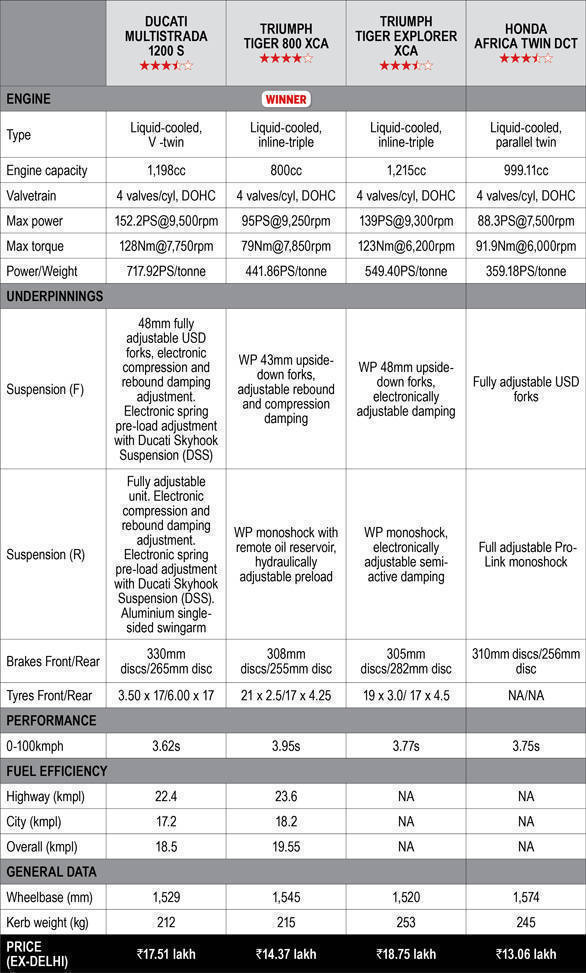
Images by Anis Shaikh and Akshay Jadhav
